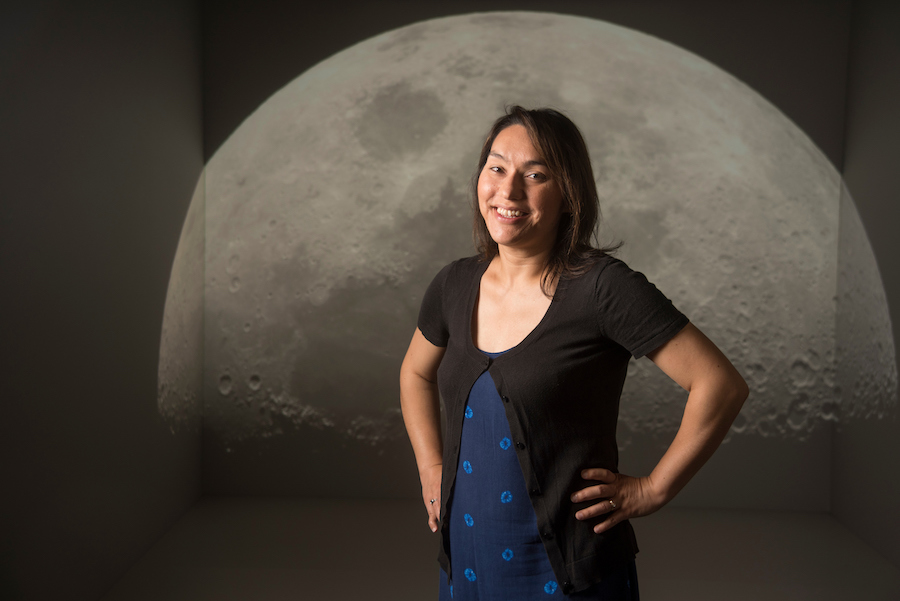
Professor Stewart recognized for contributions to planetary science, including new theory of moon formation.
Sarah Stewart, a professor of planetary science at UC Davis, won a MacArthur Fellowship, also known as a Genius Grant, last month for her work on planetary collisions and her new ideas about the formation of the moon. Stewart, who was a professor at Harvard University before moving to UC Davis, has challenged many established assumptions about the way celestial bodies collide throughout her career. She is best known for her paper proposing a completely new theory for how the moon formed.
Before her research, scientists thought that the moon was created when a Mars-sized object called Theia struck the Earth and broke apart to form a disc of debris around our home planet. They thought the moon formed when some of this debris began to coalesce and orbit Earth. The theory, which scientists call the canonical model of moon formation, seemed to fit with most of the physical evidence. However, it could not explain why rocks from the Earth and moon have nearly identical isotopic signatures.
To address this inconsistency, Stewart proposed that the Earth and moon are similar because they were made from the same mixture. She argued, in a paper published last year with Simon Lock, a postdoctoral researcher at the California Institute of Technology, that Theia struck the Earth with enough energy to vaporize most of our home planet. In this new model, the rock vapor from both Earth and Theia mixes together to form a new celestial body that Stewart and Lock call a synestia. According to this theory, the moon forms inside the synestia as the system begins to cool, and the Earth reforms as the rock vapor condenses around the synestia’s high pressure core.
“In a synestia the material will mix, everything is vaporized and the moon would form within the vapor of the synestia,” Stewart said. “The fundamental difference in our model is that the moon forms within this vaporized object, and that’s why it has the same isotopic signature of the Earth.”
Scientists will never be certain about moon formation because they can’t go back and watch the impact. Nevertheless, Stewart and Lock’s theory is now one of the leading explanations for the formation of the moon.
To reach such a monumental development, Stewart and her research team took an interesting road to discovery. Stewart did not start her research by specifically attacking the moon formation problem but instead started by studying the topic of planetary collisions.
“So most of the time, we are looking at rather general problems, so the moon work came out of trying to understand collisions in general,” Stewart said.
While Stewart and her team were studying planetary collisions more broadly, they started to notice that some of the established assumptions about the moon’s formation were wrong. In 2012, Stewart, alongside Matija Ćuk, a postdoctoral fellow at Harvard at the time, published a paper in Science which demonstrated how the Earth could have been spinning much faster at the time of impact than previously assumed. According to Ćuk, who now works as a research scientist at the SETI Institute, the research allowed more moon formation models to be proposed because the increased speed at time of impact meant the collision could have have occured with much higher energy than initially predicted.
“It kind of opened up the field of lunar formation to many new ideas,” Ćuk said.
One of these new ideas Stewart herself developed when she and her team questioned a key assumption in the canonical model. According to Lock, researchers in the field had a fixed idea that after the impact, there was a distinct Earth and a distinct moon. However, as Stewart and Lock looked carefully at the data from their computer simulations they noticed the data from their models did not support this idea.
“You were not getting a disc and a planet,” Lock said. “What you were getting is this one massive structure which we termed a synestia.”
According to Stewart, it is possible that many computers at laboratories across the country had developed the data to create the synestia theory. For Stewart and Lock, the difference was that they listened to the data and ignored the scientific assumption to uncover a better solution.
Stewart will have to carry these lesson into her future projects because there is still a lot of work to be done. Now that that basic synestia theory has been defined, Stewart and her research group are busy fleshing out the details, testing the model against increasing complex permutations and comparing it to new physical evidence from the Earth and moon.
Stewart also wants to continue to work broadly. At UC Davis she runs the shock compression lab, shooting objects at each other to gather more data about how planetary collisions might work. She wants to know more about the Earth after the giant collision as well as the formation of other planets. Stewart’s MacArthur fellowship will help provide funds and institutional support to help her answer some of these questions. Stewart will also be able to draw from her experiences developing the Synestia theory. She said the project had a lasting impact on how she approaches scientific assumptions.
“Things I had accepted before I will sit and think about a little longer and wonder, ‘should I still think that today?’” Stewart said.
Written by: Peter Smith — science@theaggie.org



